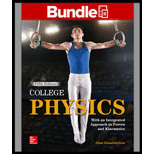
Concept explainers
(a)
The tension in the rope.
(a)
Answer to Problem 73P
The tension in the rope is
Explanation of Solution
Write the expression for the force for crate in terms of Newton’s second law along
Here,
Similarly write the expression for the force for the crate along
Here,
Write the expression for force for the box along
Similarly write the expression for the force for the box along
Here,
According to the problem
Solve for
Conclusion:
Eliminate for
Substitute
The tension in the rope is
(b)
The time required by the crate to slide down.
(b)
Answer to Problem 73P
The time required by the crate to slide down is
Explanation of Solution
Write the equation of motion, where
Here,
Re-write the expression in terms of
Conclusion:
Substitute
The time required by the crate to slide down is
(c)
The force to push the crate.
(c)
Answer to Problem 73P
The force to push the crate is
Explanation of Solution
Write the expression for the force for crate in terms of Newton’s second law along
Here,
Similarly write the expression for the force for the box along
Here,
Solve for
Conclusion:
Substitute
The force to push the crate is
(d)
The smallest mass to keep the crate from sliding down.
(d)
Answer to Problem 73P
The smallest mass is
Explanation of Solution
Write the expression for the force for crate in terms of Newton’s second law along
Here,
Similarly write the expression for the force for the crate along
Here,
Write the expression for force for the box along
Similarly write the expression for the force for the box along
Here,
Conclusion:
Thus,
Thus, substitute the expression (V) in expression (IV) and re-write the expression in terms
Substitute
The smallest mass is
Want to see more full solutions like this?
Chapter 4 Solutions
COLLEGE PHYSICS (LOOSELEAF)-W/CONNECT
 College PhysicsPhysicsISBN:9781305952300Author:Raymond A. Serway, Chris VuillePublisher:Cengage Learning
College PhysicsPhysicsISBN:9781305952300Author:Raymond A. Serway, Chris VuillePublisher:Cengage Learning University Physics (14th Edition)PhysicsISBN:9780133969290Author:Hugh D. Young, Roger A. FreedmanPublisher:PEARSON
University Physics (14th Edition)PhysicsISBN:9780133969290Author:Hugh D. Young, Roger A. FreedmanPublisher:PEARSON Introduction To Quantum MechanicsPhysicsISBN:9781107189638Author:Griffiths, David J., Schroeter, Darrell F.Publisher:Cambridge University Press
Introduction To Quantum MechanicsPhysicsISBN:9781107189638Author:Griffiths, David J., Schroeter, Darrell F.Publisher:Cambridge University Press Physics for Scientists and EngineersPhysicsISBN:9781337553278Author:Raymond A. Serway, John W. JewettPublisher:Cengage Learning
Physics for Scientists and EngineersPhysicsISBN:9781337553278Author:Raymond A. Serway, John W. JewettPublisher:Cengage Learning Lecture- Tutorials for Introductory AstronomyPhysicsISBN:9780321820464Author:Edward E. Prather, Tim P. Slater, Jeff P. Adams, Gina BrissendenPublisher:Addison-Wesley
Lecture- Tutorials for Introductory AstronomyPhysicsISBN:9780321820464Author:Edward E. Prather, Tim P. Slater, Jeff P. Adams, Gina BrissendenPublisher:Addison-Wesley College Physics: A Strategic Approach (4th Editio...PhysicsISBN:9780134609034Author:Randall D. Knight (Professor Emeritus), Brian Jones, Stuart FieldPublisher:PEARSON
College Physics: A Strategic Approach (4th Editio...PhysicsISBN:9780134609034Author:Randall D. Knight (Professor Emeritus), Brian Jones, Stuart FieldPublisher:PEARSON





